
NGC 7793 is a flocculent spiral galaxy in the southern constellation of Sculptor. It was discovered in 1826 by Scottish astronomer James Dunlop. The galaxy is located at a distance of 12.2 million light years and is receding with a heliocentric radial velocity of 227 km/s. NGC 7793 is one of the five brightest galaxies within the Sculptor Group.

NGC 5962 is a spiral galaxy in the equatorial constellation of Serpens Caput. It was discovered by the Anglo-German astronomer William Herschel on March 21, 1784. The NGC 5962 galaxy is located at a distance of 120 million light years and is receding with a heliocentric radial velocity of 1,957 km/s. It is the brightest member of the eponymously-named NGC 5962 group, which overlaps with the nearby NGC 5970 group; the two groups may be gravitationally bound.
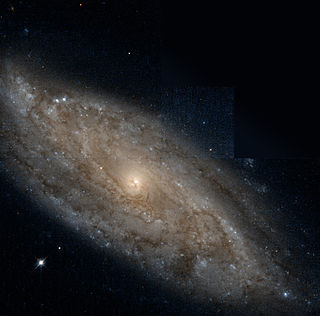
NGC 7314 is a spiral galaxy located in the southern constellation of Piscis Austrinus. It was discovered by English astronomer John Herschel on July 29, 1834. This is a nearby Seyfert (active) galaxy, located at a distance of approximately 54.6 megalight-years from the Milky Way. Since it appears to have detached spiral arm segments, it was listed in Halton Arp's Atlas of Peculiar Galaxies.

NGC 10 is a spiral galaxy located in the southern constellation of Sculptor. It was discovered by John Herschel on 25 September 1834. The galaxy is located at a distance of 346 Mly from the Sun. Its morphological classification in the De Vaucouleurs system is SAB(rs)bc, where the 'SAB' denotes a weak-barred spiral, '(rs)' indicates a slight ring-like structure, and 'bc' means the spiral arms are moderately to loosely wound. Paturel et al. (2003) assigned this galaxy a classification of SBbc, indicating a barred spiral galaxy.

NGC 27 is a spiral galaxy located in the constellation Andromeda. It was discovered on 3 August 1884 by Lewis Swift. It forms a galaxy pair with the nearby UGC 95.

NGC 3553 is a lenticular galaxy in the constellation Ursa Major. It was discovered in March 1885 by Guillaume Bigourdan. It is a member of the galaxy cluster Abell 1185.

NGC 4777 is an intermediate spiral ring galaxy. It is estimated to be about 180 million light-years away from the Sun. It was discovered on March 3, 1786 by the astronomer William Herschel.
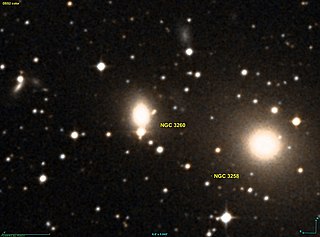
NGC 3260 is an elliptical galaxy in the constellation Antlia. It is a member of the Antlia Cluster, which lies about 40.7 megaparsecs away. It was discovered on May 2, 1834 by the astronomer John Herschel.
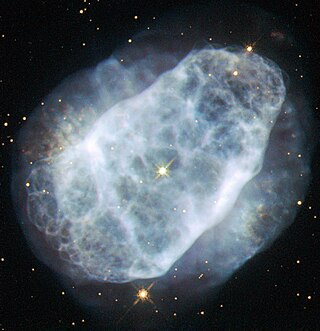
NGC 6153 is a planetary nebula in the constellation Scorpius. It was discovered in 1883 by Ralph Copeland.

NGC 63 is a spiral galaxy in the constellation Pisces. NGC 63 is its New General Catalogue designation. It has an apparent V-band magnitude of 12.70.
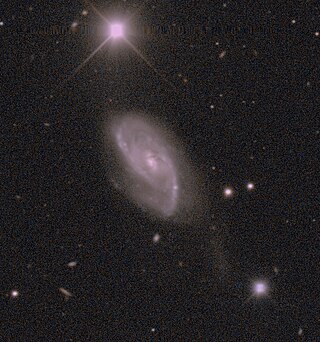
NGC 66 is a barred spiral galaxy discovered by Frank Muller in 1886, and is located in the Cetus constellation.

NGC 69 is a barred lenticular galaxy located in the constellation Andromeda. It is a member of the NGC 68 group. It was discovered in 1855 by R. J. Mitchell, who described it as "extremely faint, very small, round."

NGC 112 is a barred spiral galaxy located in the constellation Andromeda. It was discovered by American astronomer Lewis Swift on September 17, 1885. The galaxy lies approximately 295 million light-years from Earth, and is about 75,000 light-years in diameter.

NGC 120 is a lenticular galaxy of type SB0? pec? with an apparent magnitude of 13.4 located in the constellation Cetus. It was discovered on 27 September 1880 by Wilhelm Tempel.

NGC 214 is a spiral galaxy in the northern constellation of Andromeda, located at a distance of 194 megalight-years from the Milky Way. It was discovered on September 10, 1784 by William Herschel. The shape of this galaxy is given by its morphological classification of SABbc, which indicates a weak bar-like structure (SAB) at the core and moderate to loosely-wound spiral arms (bc).

NGC 6902 is an unbarred spiral galaxy located in the southern constellation of Sagittarius at an approximate distance of 124 million light-years (38.0 Mpc). NGC 6902 was discovered on September 2, 1836 by English astronomer John Herschel. In his New General Catalogue, Danish astronomer J. L. E. Dreyer described it as faint, considerably small, round, brighter middle. It is a member of the small NGC 6092 group of galaxies; the LGG 434 group
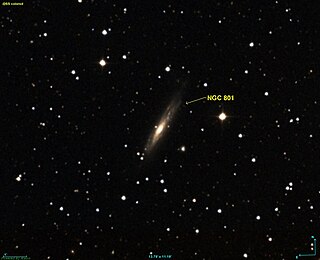
NGC 801 is a spiral galaxy with an active galaxy core in the constellation Andromeda. It is estimated to be 174 million light-years from the Milky Way and has a diameter of approximately 174,400 light-years. The object was discovered on September 20, 1885 by the American astronomer Lewis A. Swift.

NGC 1325 is a flocculent spiral galaxy situated in the constellation of Eridanus. Located about 75 million light years away, it is a member of the Eridanus cluster of galaxies, a cluster of about 200 galaxies. It was discovered by William Herschel on 19 December 1799.

NGC 3156 is a lenticular galaxy located in the constellation Sextans. It is located at a distance of about 75 million light-years from Earth and is forming a pair with NGC 3169. It was discovered by astronomer William Herschel on December 13, 1784.
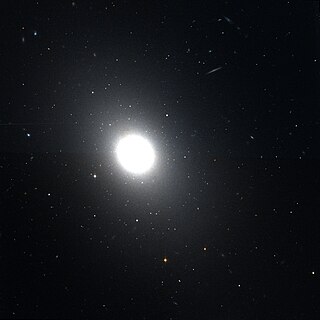
NGC 1172 is an elliptical galaxy in the constellation Eridanus. It was discovered by William Herschel on December 30, 1785.




















